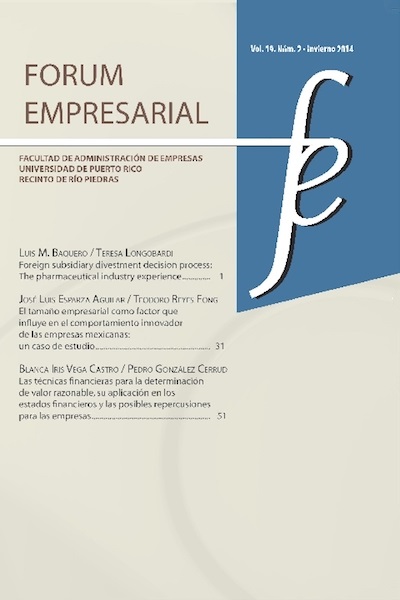Abstract
The purpose of this work is to analyze the enterprise size as a factor that influences the innovative behavior of enterprises. A survey of a sample of 221 businesses from the southern part of the state of Quintana Roo, México was used. Among the variables considered in the study, innovation of the business was used as the dependent variable. The enterprise size was used as the independent variable. For the data analysis, non parametric techniques were used. The results show that enterprise size significantly impacts the innovative behavior of businesses, and that larger businesses are more innovative.References
Aiken, M., Bacharach, S. B., & French, J. L. (1980). Organizational structure, work process, and proposal making in administrative bureaucracies. Academy of Management Journal, 23(4), 631-652.
Aragón, J. A., & Cordón, E. (2000). La influencia del tamaño, las dimensiones estratégicas y el entorno en la implantación de innovaciones en la organización: Internet en las pequeñas y medianas empresas. Investigaciones Europeas de Dirección y Economía de la Empresa, 6(2), 91-110.
Canales, D., Glover, A., González, M., & Kessler, T. (2009). Apoyando la innovación en las pymes: El estado del arte. [México, DF:] Fundación IDEA.
Camisón, C. (2000). Reflexiones sobre la investigación científica de la pyme. Investigaciones Europeas de Dirección y Economía de la Empresa, 6(2), 13-29.
Creswell, J. (2005). Educational research: Planning, conducting, and evaluating quantitative and qualitative research (2nd ed.). Upper Saddle River, NJ: Person Education.
Damanpour, F. (1992). Organizational size and innovation. Organization Studies, 13(3), 375-402.
Dean, T. J., Brown, R. L., & Bamford, C. E. (1998). Differences in large and small firm responses to environmental context: Strategic implications from a comparative analysis of business formations. Strategic Management Journal, 19(8), 709-728.
Diario Oficial de la Federación (DOF). (2009). Acuerdo por el que se establece la estratificación de las micro, pequeñas y medianas empresas. México, DF: Diario Oficial de la Federación.
Estrella, E., & Góngora, G. (2009). La pyme innovadora mexicana. Revista Gestión Joven, 14-19.
Freel, M. (2005). Perceived environment uncertainty and innovation in small firms. Small Business Economics, 25, 49-64.Galbraith, J. K. (1952). American capitalism. Boston, MA: Houghton-Miffing Co.García Docampo, M. (2007). Perspectivas teóricas en desarrollo local. La Coruña: Netbiblo, S.L.Hadjimanolis, A. (1999). Barriers to innovation for SMEs in a small less developed country (Cyprus). Technovation, 19, 561-570.
Hage, J. (1980). Theories of organizations. Nueva York, NY: Wiley.
Hair, J. F., Anderson, R. E., Tatham, R. L., & Black, W. C. (2005). Análisis multivariante (5a ed.). Madrid: Pearson Educación.
Hernández, R., Fernández, C., & Baptista, P. (2006). Metodología de la investigación (4a ed.). México, DF: McGraw-Hill.
Instituto Nacional de Estadística y Geografía (INEGI). (2010). Censos económicos 2009. México, DF: Instituto Nacional de Estadística y Geografía.
Larsen, P., & Lewis, A. (2007). How award-winning SMEs manage the barriers to innovation. Creativity and Innovation Management, 16(2), 142-151.
Lin, P., & Huang, D. (2008). Technological regimes and firm survival: Evidence across sectors and over time. Small Business Econo-mics, 30, 175-186.
López Fernández, J. M., Somohano Rodríguez, F. M., & Martínez García, F. J. (2011). La innovación y la ventaja competitiva en las pymes mexicanas. Recuperado de http://personales.ya.com/aeca/pub/on_line/comunicaciones_aal2011/cd/55k.pdf
Mathers, N., Fox, N., & Hunn, A. (1998). Surveys and questionnaires. Notthingam Trent Focus Group, 1-50.Moch, M. K., & Morse, E. V. (1977). Size, centralization and organizational adoption of innovations. American Sociological Review, 42, 716-725.
Morales Nájar, I. (2011). Las pymes en México, entre la creación fallida y la destrucción creadora. Economía Informa, 366, 39-48.
Organización para la Cooperación y el Desarrollo Económicos (OCDE) y Eurostat (2006). Manual de Oslo. Guía para la recogida e interpretación de datos sobre innovación (3a ed.). España:
Organización para la Cooperación y el Desarrollo Económicos y Eurostat.Ortiz, F. (2006). Gestión de innovación tecnológica de las pymes ma-nufactureras. En I Congreso Iberoamericano de Ciencia, Tecnología, Sociedad e Innovación CTS+ I, 1-17.
Programa Nacional de Innovación (PNI) (2011). Comité Intersec-torial para la Innovación (SE). Recuperado de http://www.economia.gob.mx/files/comunidad_negocios/innovacion/Programa_Nacional_de_Innovacion.pdf
Ruber, J. J., & Fuentes, A. M. (2003). La economía regional en el marco de la nueva economía. Valencia: Asociación Valenciana de Ciencia Regional.Sabino, C. (1984). Introducción a la metodología de la investigación. Caracas: Ariel.
Schumpeter, J. A. (1944). La teoría del desenvolvimiento económico: Una investigación sobre ganancias, capital, crédito, interés y ciclo económico. México, DF: Fondo de Cultura Económica.
Sullivan, P., & Kang, J. (1999). Quick response adoption in the apparel manufacturing industry: Competitive advantage of innovation. Journal of Small Business Management, 37, 1-13.
Vila, M., Ferro, C., & Guisado, M. (2010). Innovación, financia-ción pública y tamaño empresarial. Cuadernos de Gestión, 10(1), 75-87.
By submitting a contribution to consideration of the Editorial Board of Fórum Empresarial, the authors attest that it is an original, unpublished work, which has not been nor will be simultaneously submitted to another journal for consideration and publication; that they are responsible for the work carried out and the content of the article; and they have the corresponding copyrights.
The authors grant the right of first publication of their work to Fórum Empresarial, in any medium and physical and electronic format, including internet. Publication shall be subject to the Creative Commons Attribution-NonCommercial 4.0 International License, which allows third parties to share the work, provided that the author and Fórum Empresarial (as a first publication) are cited.
The journal allows authors to retain publishing rights without restrictions. Authors are able to enter into separate, additional arrangements for the non-exclusive distribution of the journal's published version of the work (e.g., post it to an institutional repository or publish it in a book), with an acknowledgment of its initial publication in Fórum Empresarial.

